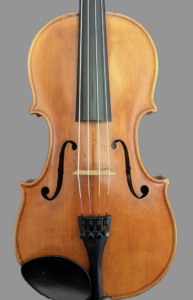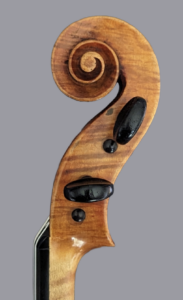
A Viola by John circa 1800
The Betts company was founded by John Betts in 1782 and ran until its closure by his nephews in 1867. The 85 years of trading musical instruments witnessed great cultural shifts brought about by revolution, industry, colonisation and war. The musical world was by no means immune, moving from the classical period exemplified by Mozart and Haydn, informed by enlightenment principles, to the dramatic romanticism of Beethoven. This shift included the development of the celebrity musician, playing in front of larger ensembles and far larger public audiences. Violinists such as Giovanni Baptista Viotti and later, Nicolo Paganini found the Cremonese instruments of Antonius Stradivari and Joseph Guarneri del Gesu tonally preferable for such use than those made earlier by Jacob Stainer and Nicolo Amati. The period under study saw the replacement of the latter with the former at the top of the stringed instrument market.

John Betts was born near Stamford, Lincolnshire in 1755, the same year as Count Cozio di Salabue’s birth in Milan. Betts shared a similar enthusiasm for the work of Stradivari, traced back to his earliest advertisements where he led with Stradivarius as the model for which his own instruments would copy. Indeed, the vast majority of the instruments produced by him and his workshop follow a Strad or, less commonly, an Amati model with Stainer copies extremely rare. He was therefore ideally placed to capitalise on the promotion of Stradivarius’ instruments by Viotti and others, trading them internationally as well as using them as inspiration. His workshop produced some of the greatest instruments to have been made on English soil, employing various talented workmen. In this way, he can be viewed as the forerunner to the business Jean Baptist Vuillaume ran in Paris which began shortly after his death.

The Betts business, continued by his brother Arthur after 1823. maintained a dominant position in London until after Arthur’s death in 1747, but began to wane under the stewardship of Arthur’s sons. When it was eventually closed in 1867, the business run by William Ebsworth Hill and his sons was on the path towards global prominence. These essays will begin with a short biography of the Betts family members in an abbreviated dictionary format. The same will be presented for some of the key makers associated, including the Fendts, Panormos, Hills, Dodds, Tobins and Furbers. This will then be expanded on in a series of longer articles, expanding on various subjects, presenting theories based on the many primary sources mow available. Subjects will include; background and origins; The formation of the Betts business at the Royal Exchange in the context of the musical instrument market in London; The Betts workshop, its employees and how instrument makers in London worked; The Betts clientele and their influence in England and abroad; The instruments made for and sold by the Betts company and their developments; The business fortunes and personal disputes; The Betts instruments in the context of pan European trends during the late eighteenth and early 19th century and; The company’s eventual decline.



Your blog is a true hidden gem on the internet. Your thoughtful analysis and engaging writing style set you apart from the crowd. Keep up the excellent work!